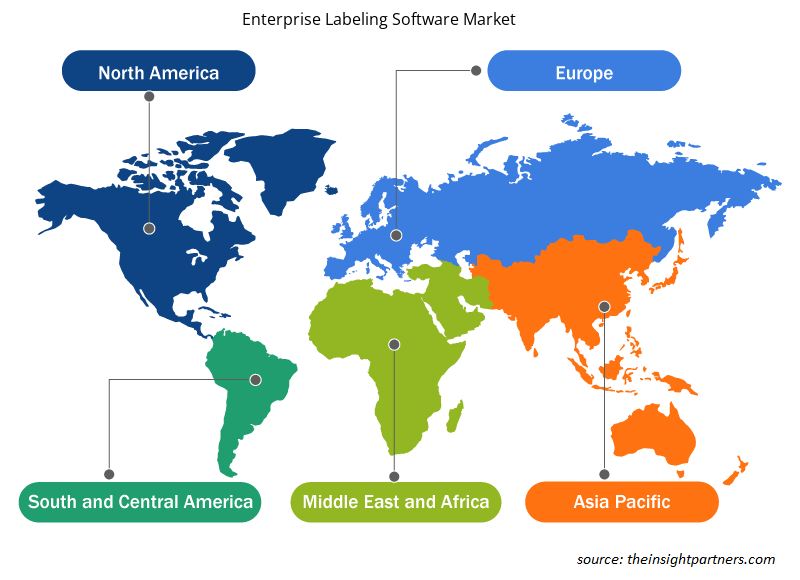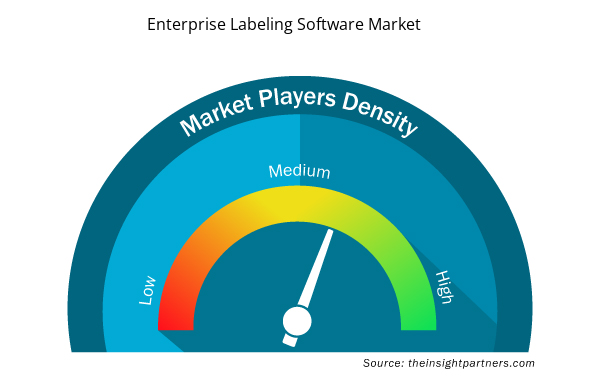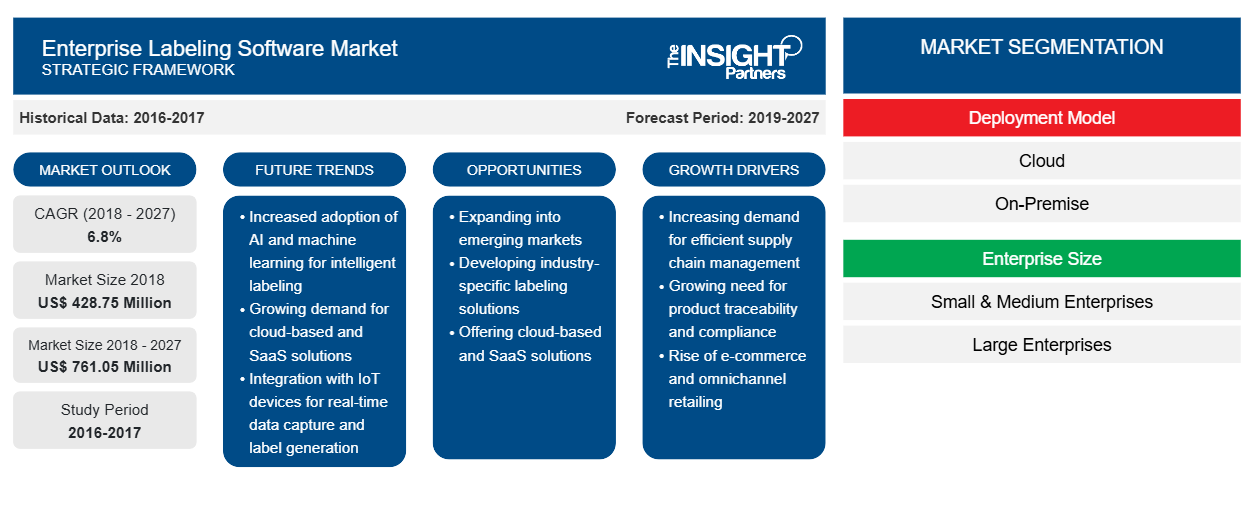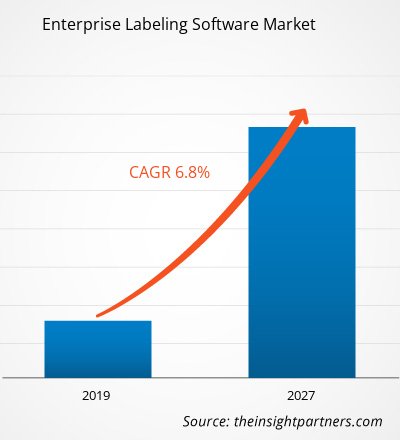بلغت قيمة سوق برامج وضع العلامات التجارية 428.75 مليون دولار أمريكي في عام 2018 ومن المتوقع أن تصل إلى 761.05 مليون دولار أمريكي بحلول عام 2027 بمعدل نمو سنوي مركب قدره 6.8٪ خلال الفترة المتوقعة.
أدى التوسع في مختلف الصناعات ذات الاستخدام النهائي في جميع أنحاء العالم، وخاصة في منطقة آسيا والمحيط الهادئ والشرق الأوسط وأفريقيا، إلى جانب تطور إدارة البيانات والتخطيط في السنوات القليلة الماضية، إلى إدخال عملية وضع العلامات كعملية بالغة الأهمية بالنسبة للعديد من الشركات الصغيرة والمتوسطة الحجم. هناك حاجة متزايدة لوضع العلامات على مستوى المؤسسات في مختلف الصناعات ذات الاستخدام النهائي لتبسيط العمليات التجارية المتعددة. يساعد برنامج وضع العلامات على مستوى المؤسسات في الحفاظ على الدقة أثناء عملية الطباعة ويضمن امتثال الشركات للوائح الكشف عن معلومات المنتج. بالإضافة إلى ذلك، يوفر دمج هذا البرنامج فوائد مختلفة، بما في ذلك التعاون في البيانات على مستوى المؤسسة، وكفاءة سلسلة التوريد، ومرونة طباعة الملصقات وتناسقها. لذلك، من المتوقع أن يؤدي التبني المتزايد لوضع العلامات على مستوى المؤسسات إلى دفع نمو سوق برامج وضع العلامات على مستوى المؤسسات
يعمل برنامج وضع العلامات التجارية على تحسين السرعة والدقة والكفاءة وتوفير التكاليف ووقت التسليم، مع تمكين الشركات من معالجة تحديات وضع العلامات المعقدة. تساعد جودة وضع العلامات المحسنة في تحسين القدرة التنافسية للشركة في السوق العالمية.
قم بتخصيص هذا التقرير ليناسب متطلباتك
ستحصل على تخصيص لأي تقرير - مجانًا - بما في ذلك أجزاء من هذا التقرير، أو تحليل على مستوى الدولة، وحزمة بيانات Excel، بالإضافة إلى الاستفادة من العروض والخصومات الرائعة للشركات الناشئة والجامعات
- احصل على أهم اتجاهات السوق الرئيسية لهذا التقرير.ستتضمن هذه العينة المجانية تحليلاً للبيانات، بدءًا من اتجاهات السوق وحتى التقديرات والتوقعات.
رؤى إقليمية حول سوق برامج وضع العلامات التجارية للمؤسسات
لقد قام المحللون في Insight Partners بشرح الاتجاهات والعوامل الإقليمية المؤثرة على سوق برامج وضع العلامات التجارية خلال فترة التوقعات بشكل شامل. يناقش هذا القسم أيضًا قطاعات سوق برامج وضع العلامات التجارية والجغرافيا في جميع أنحاء أمريكا الشمالية وأوروبا ومنطقة آسيا والمحيط الهادئ والشرق الأوسط وأفريقيا وأمريكا الجنوبية والوسطى.

- احصل على البيانات الإقليمية المحددة لسوق برامج وضع العلامات التجارية للمؤسسات
نطاق تقرير سوق برامج وضع العلامات التجارية
| سمة التقرير | تفاصيل |
|---|---|
| حجم السوق في عام 2018 | 428.75 مليون دولار أمريكي |
| حجم السوق بحلول عام 2027 | 761.05 مليون دولار أمريكي |
| معدل النمو السنوي المركب العالمي (2018 - 2027) | 6.8% |
| البيانات التاريخية | 2016-2017 |
| فترة التنبؤ | 2019-2027 |
| القطاعات المغطاة | حسب نموذج النشر
|
| المناطق والدول المغطاة | أمريكا الشمالية
|
| قادة السوق وملفات تعريف الشركات الرئيسية |
|
كثافة اللاعبين في سوق برامج وضع العلامات التجارية للمؤسسات: فهم تأثيرها على ديناميكيات الأعمال
يشهد سوق برامج وضع العلامات التجارية نموًا سريعًا، مدفوعًا بالطلب المتزايد من المستخدم النهائي بسبب عوامل مثل تفضيلات المستهلك المتطورة والتقدم التكنولوجي والوعي المتزايد بفوائد المنتج. ومع ارتفاع الطلب، تعمل الشركات على توسيع عروضها والابتكار لتلبية احتياجات المستهلكين والاستفادة من الاتجاهات الناشئة، مما يؤدي إلى زيادة نمو السوق.
تشير كثافة اللاعبين في السوق إلى توزيع الشركات أو المؤسسات العاملة في سوق أو صناعة معينة. وهي تشير إلى عدد المنافسين (اللاعبين في السوق) الموجودين في مساحة سوق معينة نسبة إلى حجمها أو قيمتها السوقية الإجمالية.
الشركات الرئيسية العاملة في سوق برمجيات وضع العلامات التجارية هي:
- بلو للبرمجيات، ذ.م.م
- شركة سيبرا
- شركة داتا سيستمز الدولية المحدودة (DSI)
- إنديسيا،
- شركة يورو بلس المحدودة
إخلاء المسؤولية : الشركات المذكورة أعلاه ليست مرتبة بأي ترتيب معين.

- احصل على نظرة عامة على أهم اللاعبين الرئيسيين في سوق برامج وضع العلامات التجارية للمؤسسات
يركز اللاعبون العاملون في سوق إدارة محتوى المؤسسات على استراتيجيات مثل عمليات الدمج والاستحواذ ومبادرات السوق للحفاظ على مواقعهم في السوق. فيما يلي قائمة ببعض التطورات التي قام بها اللاعبون الرئيسيون:
- في نوفمبر 2019، أطلقت NiceLabel الإصدار 2 من حزمة ABAP الخاصة بها، والتي تدعم كلًا من SAP ECC وSAP S/4HANA. يتيح هذا للمؤسسات رقمنة عملية ضمان جودة الملصقات بالكامل والحد من أخطاء الملصقات وتأخيرات الشحن.
- في أبريل 2018، أعلنت شركة Innovatum، Inc. عن حصولها على شهادة ISO 9001:2015 لنظام إدارة الجودة الخاص بتطوير البرامج وتسليمها ودعمها كمزود لبرامج العلوم الحياتية، من قبل هيئة معتمدة من ANAB.
أقسام سوق برامج وضع العلامات التجارية العالمية:
سوق برامج وضع العلامات التجارية للمؤسسات – حسب نموذج النشر
- في الموقع
- سحاب
سوق برامج وضع العلامات التجارية للمؤسسات – حسب حجم المؤسسة
- الشركات الصغيرة والمتوسطة
- الشركات الكبيرة
سوق برامج وضع العلامات التجارية للمؤسسات – حسب المستخدم النهائي
- السلع الاستهلاكية سريعة التداول
- بيع بالتجزئة
- الرعاية الصحية
- التخزين والخدمات اللوجستية
- آحرون
سوق برامج وضع العلامات التجارية للمؤسسات – حسب المنطقة الجغرافية
أمريكا الشمالية
- نحن
- كندا
- المكسيك
أوروبا
- فرنسا
- ألمانيا
- إيطاليا
- إسبانيا
- المملكة المتحدة
- بقية أوروبا
آسيا والمحيط الهادئ (APAC)
- أستراليا
- الصين
- الهند
- اليابان
- بقية منطقة آسيا والمحيط الهادئ
الشرق الأوسط وأفريقيا
- المملكة العربية السعودية
- الامارات العربية المتحدة
- جنوب أفريقيا
- باقي منطقة الشرق الأوسط وأفريقيا
أمريكا الجنوبية (SAM)
- البرازيل
- بقية سام
شركات
- شركة بلو للبرمجيات المحدودة (إيسكو)
- شركة سيبرا
- شركة داتا سيستمز الدولية المحدودة (DSI)
- إنديسيا
- يورو بلس المحدودة
- شركة إينوفاتوم
- شركة لوفتوير
- شركة بريسيم أي دي المحدودة
- شركة سيجال العلمية
- تيكلينكس نيوكو ساس
- التحليل التاريخي (سنتان)، السنة الأساسية، التوقعات (7 سنوات) مع معدل النمو السنوي المركب
- تحليل PEST و SWOT
- حجم السوق والقيمة / الحجم - عالميًا وإقليميًا وقطريًا
- الصناعة والمنافسة
- مجموعة بيانات Excel



Report Coverage
Revenue forecast, Company Analysis, Industry landscape, Growth factors, and Trends

Segment Covered
This text is related
to segments covered.

Regional Scope
North America, Europe, Asia Pacific, Middle East & Africa, South & Central America

Country Scope
This text is related
to country scope.
الأسئلة الشائعة
Various end-use industries have used reporting solutions and business intelligence (BI) with many of their enterprise applications to improve business operations. Companies are looking forward to using BI to monitor labels printed across facilities to ensure that the quality of labels printed is in line with the expected output of a facility. Moreover, they are looking forward to using this insight for better maintenance schedules for printers and analyzing trends in the label production to fine-tune labeling environments. Therefore, the use of analytics with enterprise labeling is a major emerging trend for enterprise labeling software market.
The growth of the enterprise labeling software market in Europe is primarily attributed to the strong retail industry in countries such as India, China, and Japan, owing to the strong customer base. Also, the FMCG industry in countries such as India and China plays a vital role in supporting any country’s economy. Since the demand for enterprise labeling software is high across the FMCG sector; therefore, a strong FMCG sector supports the increasing demand for enterprise labeling software in the region.
The growing demand for enterprise labeling software in end-use industries in emerging economies such as MEA and APAC is driving the growth of enterprise labeling software market. Also, the surging demand for flexible enterprise labeling solutions to reduce the inconsistency, and improve efficiency is also a major driving factor for the enterprise labeling software market.
Trends and growth analysis reports related to Technology, Media and Telecommunications : READ MORE..
The List of Companies
- BLUE Software, LLC
- CYBRA Corporation
- Data Systems International, Inc. (DSI)
- Endicia,
- Euro Plus Ltd.
- Innovatum, Inc.
- Loftware, Inc.
- PRISYM ID Ltd.
- Seagull Scientific, Inc.
- Teklynx Newco SAS.
The Insight Partners performs research in 4 major stages: Data Collection & Secondary Research, Primary Research, Data Analysis and Data Triangulation & Final Review.
- Data Collection and Secondary Research:
As a market research and consulting firm operating from a decade, we have published and advised several client across the globe. First step for any study will start with an assessment of currently available data and insights from existing reports. Further, historical and current market information is collected from Investor Presentations, Annual Reports, SEC Filings, etc., and other information related to company’s performance and market positioning are gathered from Paid Databases (Factiva, Hoovers, and Reuters) and various other publications available in public domain.
Several associations trade associates, technical forums, institutes, societies and organization are accessed to gain technical as well as market related insights through their publications such as research papers, blogs and press releases related to the studies are referred to get cues about the market. Further, white papers, journals, magazines, and other news articles published in last 3 years are scrutinized and analyzed to understand the current market trends.
- Primary Research:
The primarily interview analysis comprise of data obtained from industry participants interview and answers to survey questions gathered by in-house primary team.
For primary research, interviews are conducted with industry experts/CEOs/Marketing Managers/VPs/Subject Matter Experts from both demand and supply side to get a 360-degree view of the market. The primary team conducts several interviews based on the complexity of the markets to understand the various market trends and dynamics which makes research more credible and precise.
A typical research interview fulfils the following functions:
- Provides first-hand information on the market size, market trends, growth trends, competitive landscape, and outlook
- Validates and strengthens in-house secondary research findings
- Develops the analysis team’s expertise and market understanding
Primary research involves email interactions and telephone interviews for each market, category, segment, and sub-segment across geographies. The participants who typically take part in such a process include, but are not limited to:
- Industry participants: VPs, business development managers, market intelligence managers and national sales managers
- Outside experts: Valuation experts, research analysts and key opinion leaders specializing in the electronics and semiconductor industry.
Below is the breakup of our primary respondents by company, designation, and region:

Once we receive the confirmation from primary research sources or primary respondents, we finalize the base year market estimation and forecast the data as per the macroeconomic and microeconomic factors assessed during data collection.
- Data Analysis:
Once data is validated through both secondary as well as primary respondents, we finalize the market estimations by hypothesis formulation and factor analysis at regional and country level.
- Macro-Economic Factor Analysis:
We analyse macroeconomic indicators such the gross domestic product (GDP), increase in the demand for goods and services across industries, technological advancement, regional economic growth, governmental policies, the influence of COVID-19, PEST analysis, and other aspects. This analysis aids in setting benchmarks for various nations/regions and approximating market splits. Additionally, the general trend of the aforementioned components aid in determining the market's development possibilities.
- Country Level Data:
Various factors that are especially aligned to the country are taken into account to determine the market size for a certain area and country, including the presence of vendors, such as headquarters and offices, the country's GDP, demand patterns, and industry growth. To comprehend the market dynamics for the nation, a number of growth variables, inhibitors, application areas, and current market trends are researched. The aforementioned elements aid in determining the country's overall market's growth potential.
- Company Profile:
The “Table of Contents” is formulated by listing and analyzing more than 25 - 30 companies operating in the market ecosystem across geographies. However, we profile only 10 companies as a standard practice in our syndicate reports. These 10 companies comprise leading, emerging, and regional players. Nonetheless, our analysis is not restricted to the 10 listed companies, we also analyze other companies present in the market to develop a holistic view and understand the prevailing trends. The “Company Profiles” section in the report covers key facts, business description, products & services, financial information, SWOT analysis, and key developments. The financial information presented is extracted from the annual reports and official documents of the publicly listed companies. Upon collecting the information for the sections of respective companies, we verify them via various primary sources and then compile the data in respective company profiles. The company level information helps us in deriving the base number as well as in forecasting the market size.
- Developing Base Number:
Aggregation of sales statistics (2020-2022) and macro-economic factor, and other secondary and primary research insights are utilized to arrive at base number and related market shares for 2022. The data gaps are identified in this step and relevant market data is analyzed, collected from paid primary interviews or databases. On finalizing the base year market size, forecasts are developed on the basis of macro-economic, industry and market growth factors and company level analysis.
- Data Triangulation and Final Review:
The market findings and base year market size calculations are validated from supply as well as demand side. Demand side validations are based on macro-economic factor analysis and benchmarks for respective regions and countries. In case of supply side validations, revenues of major companies are estimated (in case not available) based on industry benchmark, approximate number of employees, product portfolio, and primary interviews revenues are gathered. Further revenue from target product/service segment is assessed to avoid overshooting of market statistics. In case of heavy deviations between supply and demand side values, all thes steps are repeated to achieve synchronization.
We follow an iterative model, wherein we share our research findings with Subject Matter Experts (SME’s) and Key Opinion Leaders (KOLs) until consensus view of the market is not formulated – this model negates any drastic deviation in the opinions of experts. Only validated and universally acceptable research findings are quoted in our reports.
We have important check points that we use to validate our research findings – which we call – data triangulation, where we validate the information, we generate from secondary sources with primary interviews and then we re-validate with our internal data bases and Subject matter experts. This comprehensive model enables us to deliver high quality, reliable data in shortest possible time.


 احصل على عينة مجانية لهذا التقرير
احصل على عينة مجانية لهذا التقرير